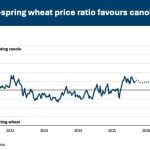Western Canadian farmers are expected to plant 52 to 56 million acres this year, according to Viterra’s chief executive officer.
Speaking to grain industry analysts during a conference call last week, Mayo Schmidt reported company profits of $33 million for the three month period ending April 30 and estimated that prairie farmers would at least match last year’s seeded area of 52 million acres.
He also predicted a hectic pace for the company’s Canadian and Australian grain handling units over the next six months.
Read Also

Farmers urged to be grain-safe this fall
Working around grain bins comes with risk, from farmers falling to drowning in grain: Experts have five tips to help avoid grain-related accidents this harvest.
Seeding is nearing completion in Western Canada and South Australia, where most of Viterra’s Australian grain handling infrastructure is based.
As of last week, producers in both regions had 80 percent of their acres seeded.
Growing conditions across most of South Australia are ideal and crops there are off to a good start.
Producers in Canada and Australia are also expected to carry significant tonnage forward into the first quarter of the 2012 fiscal year, he said.
If that happens and farmers harvest a decent crop, Viterra could handle higher-than-normal grain volumes between now and the end of the calendar year.
“For the remainder of fiscal 2011, we expect grain marketing to be swift out of both of our growing regions, given the robust commodity pricing environment and strong demand,” Schmidt said.
“And we are well positioned for the first half of fiscal 2012 as we estimate a large carryover in South Australia of between two and three million tonnes, which is about half of a typical crop for this region.”
North American carryover was estimated at four to six million tonnes.
Schmidt said western Canadian farmers got a slow start on seeding this year because of cool, wet weather. However, they made rapid progress in May.
The slow start meant many prairie farmers delayed crop input purchases until the last minute, which hurt Viterra’s second quarter crop input sales.
Input revenues picked up significantly in May with most farm retail outlets running flat out to meet producer demand.
Third quarter results should reflect that increased activity, Schmidt said.
“May was a strong month and we expect a strong third quarter from our agri-products business,” he said.
If Viterra’s acreage estimates for Western Canada hold true, a 56 million acre crop would represent a 7.7 percent increase over 2010.
In South Australia, seeded acreage is expected to be up four percent over last year to 9.6 million acres, Schmidt added.
That’s 13 percent higher than the region’s 10-year average.
Viterra second quarter profits were up 80 percent from $18 million in the same three months of 2010.
Schmidt said much of the improvement was due to the company’s Australian operations, which accounted for more than 50 percent of second quarter earnings before interest, taxes, depreciation and amortization.
Viterra acquired Australia’s ABB Grain in 2009 for $1.4 billion in an effort to reduce risk and source grain from more than one of the world’s key grain producing areas.
Since then, the company has expanded its grain handling network in Australia and has looked for ways to streamline its grain handling operations in that country.
Schmidt said Viterra’s South Australian operations handled record grain shipments in the second quarter and achieved a sustainable reduction in per tonne grain handling costs.
“Viterra’s expansion into Australia has delivered the desired results and is achieving the objective of our multiple origin sourcing strategy,” Schmidt said.
“The business is fully integrated into our operations and we are pleased to report that we achieved our stated synergy objective of (saving) $30 million six months ahead of schedule.”
Schmidt said the company fully supports the Canadian government’s objective of dismantling the Canadian Wheat Board’s marketing monopoly on wheat and barley by August 2012.
He said a revamped marketing system for board grain would give industry leaders like Viterra more flexibility and allow them to maximize logistical capabilities and handle grain more efficiently.
Under the new system, farmers would benefit from increased throughput velocities and enhanced rail car delivery, he added.
“We believe these changes will result in greater returns for agricultural producers, the industry as a whole and therefore Viterra shareholders as well.”
———
Earnings per share
———
$0.05















